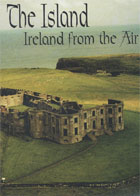
The Island: Ireland from the Air 2003
Distributed by Janson Media, 88 Semmons Road, Harrington Park, NJ 07640; 201-784-8488
Produced by Will Harris
Directed by Will Harris
DVD, color, 80 min.
Jr. High - Adult
Area Studies, European Studies, Geography, History, Travel and Tourism
Date Entered: 11/22/2005
Reviewed by Karen MacArthur, Kansas State UniversityThis documentary is comprised completely of absolutely beautiful aerial images filmed from above Ireland in a helicopter. A narrator explains the significance of each location shown and the connections between each sequence suggest the next location; the narration does not follow a strictly chronological timeline. Some of the images are seen from reasonably high above, others are shown close enough that architectural details are easily noticed.
The narration covers a huge range of history, from pagans to druids to Christian influence on architecture, to man-made islands, Viking invasions, the introduction of the potato, the building of castles and Irish displacement, man-made canals, traditional farming, the Black Plague, pirates, Sir Walter Raleigh, and a gladiator’s arena. Each location gets some commentary but because there are so many there isn’t sufficient time to learn many specifics. We hear tidbits of facts about locations, such as that in 1588 the Spanish Armada faced a hurricane in the English Channel and only three galleons made it to the Irish shore. Most statements however, are far vaguer. As an example, the Hill of Tara “had a ritual and strategic importance for thousands of years” but we don’t hear very much more about it before the film moves on to the next location.
The videography is gorgeous and generally the sound quality is excellent, except now and then the music is overwhelming. The subtitles are easily read and display long enough for the viewer to absorb the unfamiliar names. Some of the images are repeated as different aspects of the same location are revealed. For example, we see the same shot of Dublin as the narration calls it the capitol city and then again when the commentary shifts to the trends toward urban population. Once or twice the shadow of the helicopter filming the video is apparent.
Some way of depicting the location of these places might have been helpful, such as a small inset of a map on the screen, because otherwise viewers unfamiliar with Irish geography will need a map to follow all the counties and mountains shown. Every so often geologic terms that may be unfamiliar to the audience are introduced and not explained (e.g. drumlin). This film functions as an introduction to the range of Irish history but does not supply adequate content to stand on its own. Up to the last 10 minutes or so when footage of modern pollution is shown, the film also works as a very enticing travel video. This documentary is recommended only as an introduction to Irish history and geography or as a travel video.